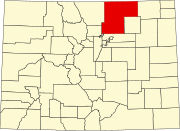LaSalle, Colorado
Town of LaSalle, Colorado | |
|---|---|
Statutory Town | |
 Entering LaSalle from the south on U.S. Route 85. | |
 Location of the Town of LaSalle in Weld County, Colorado. | |
| Coordinates: 40°21′2″N 104°42′10″W / 40.35056°N 104.70278°WCoordinates: 40°21′2″N 104°42′10″W / 40.35056°N 104.70278°W | |
| Country | |
| State | |
| County[1] | Weld |
| Incorporated (town) | 1910[2] |
| Government | |
| • Type | Statutory Town[1] |
| Area | |
| • Total | 0.96 sq mi (2.48 km2) |
| • Land | 0.96 sq mi (2.48 km2) |
| • Water | 0.00 sq mi (0.00 km2) |
| Elevation | 4,678 ft (1,426 m) |
| Population (2010) | |
| • Total | 1,955 |
| • Estimate (2019)[6] | 2,342 |
| • Density | 2,444.68/sq mi (944.17/km2) |
| Time zone | UTC-7 (Mountain (MST)) |
| • Summer (DST) | UTC-6 (MDT) |
| ZIP code[5] | 80645 |
| Area code(s) | 970 |
| FIPS code | 08-43605 |
| GNIS feature ID | 0180726 |
| Website | Town of LaSalle |
The Town of LaSalle (incorporated in 1910 as the Town of La Salle) is a Statutory Town in Weld County, Colorado, United States. The town population was 1955 at the 2010 United States Census.
A post office called La Salle has been in operation since 1886.[7] The community was named by railroad officials after LaSalle Street in Chicago.[8]
Geography[]
LaSalle is located at 40°21′2″N 104°42′10″W / 40.35056°N 104.70278°W (40.350681, -104.702914).[9]
According to the United States Census Bureau, the town has a total area of 0.7 square miles (1.8 km2), all of it land.
Demographics[]
| Historical population | |||
|---|---|---|---|
| Census | Pop. | %± | |
| 1920 | 460 | — | |
| 1930 | 564 | 22.6% | |
| 1940 | 755 | 33.9% | |
| 1950 | 797 | 5.6% | |
| 1960 | 1,070 | 34.3% | |
| 1970 | 1,227 | 14.7% | |
| 1980 | 1,929 | 57.2% | |
| 1990 | 1,783 | −7.6% | |
| 2000 | 1,849 | 3.7% | |
| 2010 | 1,955 | 5.7% | |
| 2019 (est.) | 2,342 | [6] | 19.8% |
| U.S. Decennial Census[10] | |||
As of the census[11] of 2000, there were 1,849 people, 651 households, and 486 families residing in the town. The population density was 2,675.3 people per square mile (1,034.6/km2). There were 669 housing units at an average density of 968.0 per square mile (374.4/km2). The racial makeup of the town was 78.85% White, 0.38% African American, 0.76% Native American, 0.16% Asian, 0.22% Pacific Islander, 16.12% from other races, and 3.52% from two or more races. Hispanic or Latino of any race were 31.64% of the population.
There were 651 households, out of which 39.2% had children under the age of 18 living with them, 60.5% were married couples living together, 11.1% had a female householder with no husband present, and 25.2% were non-families. 18.7% of all households were made up of individuals, and 9.4% had someone living alone who was 65 years of age or older. The average household size was 2.84 and the average family size was 3.30.
In the town, the population was spread out, with 30.1% under the age of 18, 8.3% from 18 to 24, 27.7% from 25 to 44, 23.5% from 45 to 64, and 10.4% who were 65 years of age or older. The median age was 33 years. For every 100 females, there were 101.6 males. For every 100 females age 18 and over, there were 98.0 males.
The median income for a household in the town was $41,534, and the median income for a family was $46,442. Males had a median income of $30,673 versus $22,292 for females. The per capita income for the town was $18,262. About 10.4% of families and 12.0% of the population were below the poverty line, including 18.2% of those under age 18 and 8.9% of those age 65 or over.
See also[]
- Outline of Colorado
- State of Colorado
- Colorado cities and towns
- Colorado municipalities
- Colorado counties
- Colorado metropolitan areas
- Front Range Urban Corridor
- North Central Colorado Urban Area
- Denver-Aurora-Boulder, CO Combined Statistical Area
- Greeley, CO Metropolitan Statistical Area
- Colorado cities and towns
References[]
- ^ Jump up to: a b "Active Colorado Municipalities". State of Colorado, Department of Local Affairs. Archived from the original on 2009-12-12. Retrieved 2007-09-01.
- ^ "Colorado Municipal Incorporations". State of Colorado, Department of Personnel & Administration, Colorado State Archives. 2004-12-01. Retrieved 2007-09-02.
- ^ "2019 U.S. Gazetteer Files". United States Census Bureau. Retrieved July 1, 2020.
- ^ "US Board on Geographic Names". United States Geological Survey. 2007-10-25. Retrieved 2008-01-31.
- ^ "ZIP Code Lookup". United States Postal Service. Archived from the original (JavaScript/HTML) on November 4, 2010. Retrieved October 23, 2007.
- ^ Jump up to: a b "Population and Housing Unit Estimates". United States Census Bureau. May 24, 2020. Retrieved May 27, 2020.
- ^ "Post offices". Jim Forte Postal History. Retrieved 29 June 2016.
- ^ Dawson, John Frank. Place names in Colorado: why 700 communities were so named, 150 of Spanish or Indian origin. Denver, CO: The J. Frank Dawson Publishing Co. p. 31.
- ^ "US Gazetteer files: 2010, 2000, and 1990". United States Census Bureau. 2011-02-12. Retrieved 2011-04-23.
- ^ "Census of Population and Housing". Census.gov. Retrieved June 4, 2015.
- ^ "U.S. Census website". United States Census Bureau. Retrieved 2008-01-31.
External links[]
- Towns in Colorado
- Towns in Weld County, Colorado

